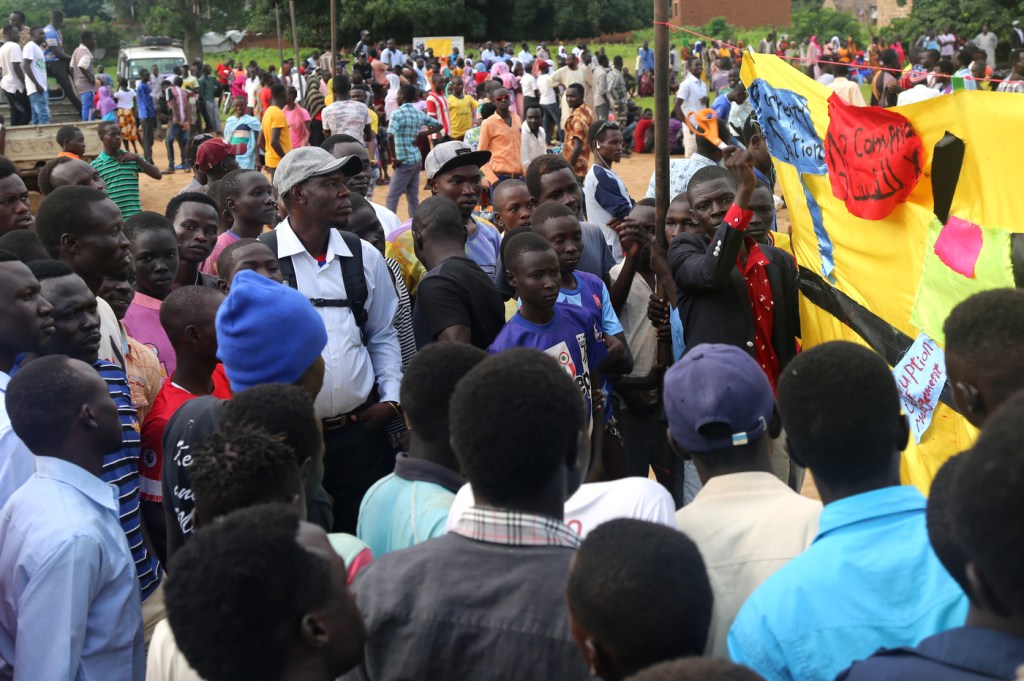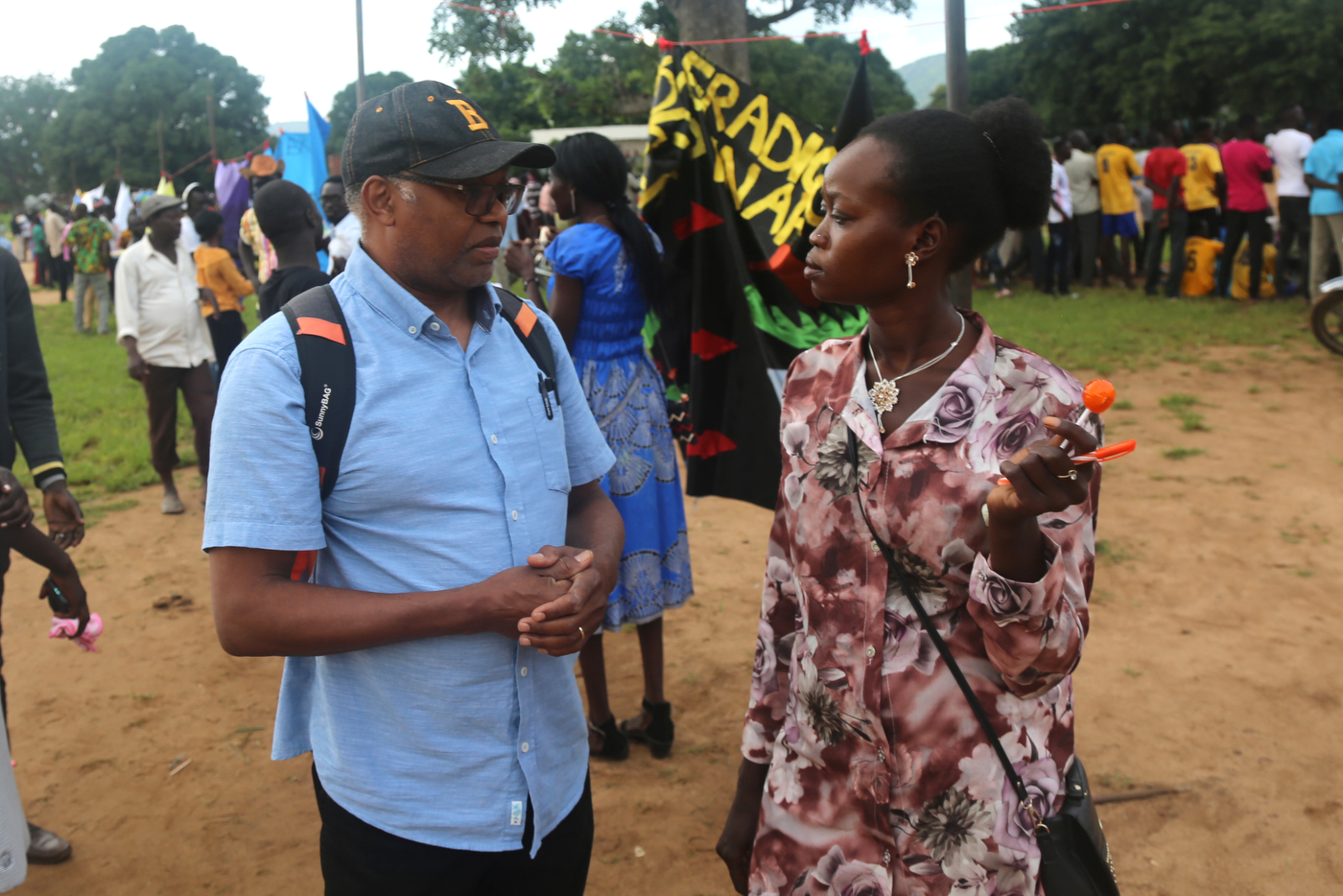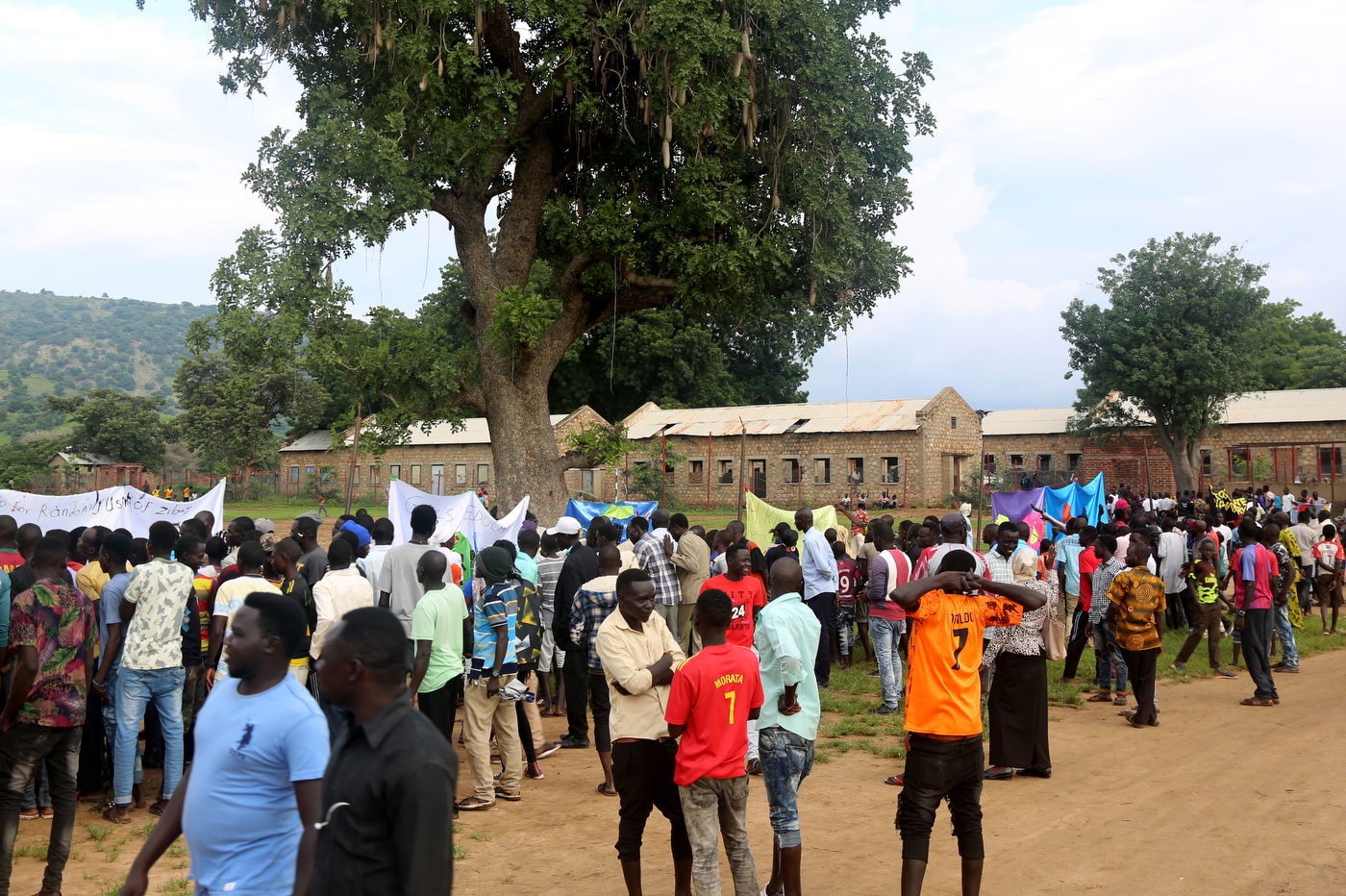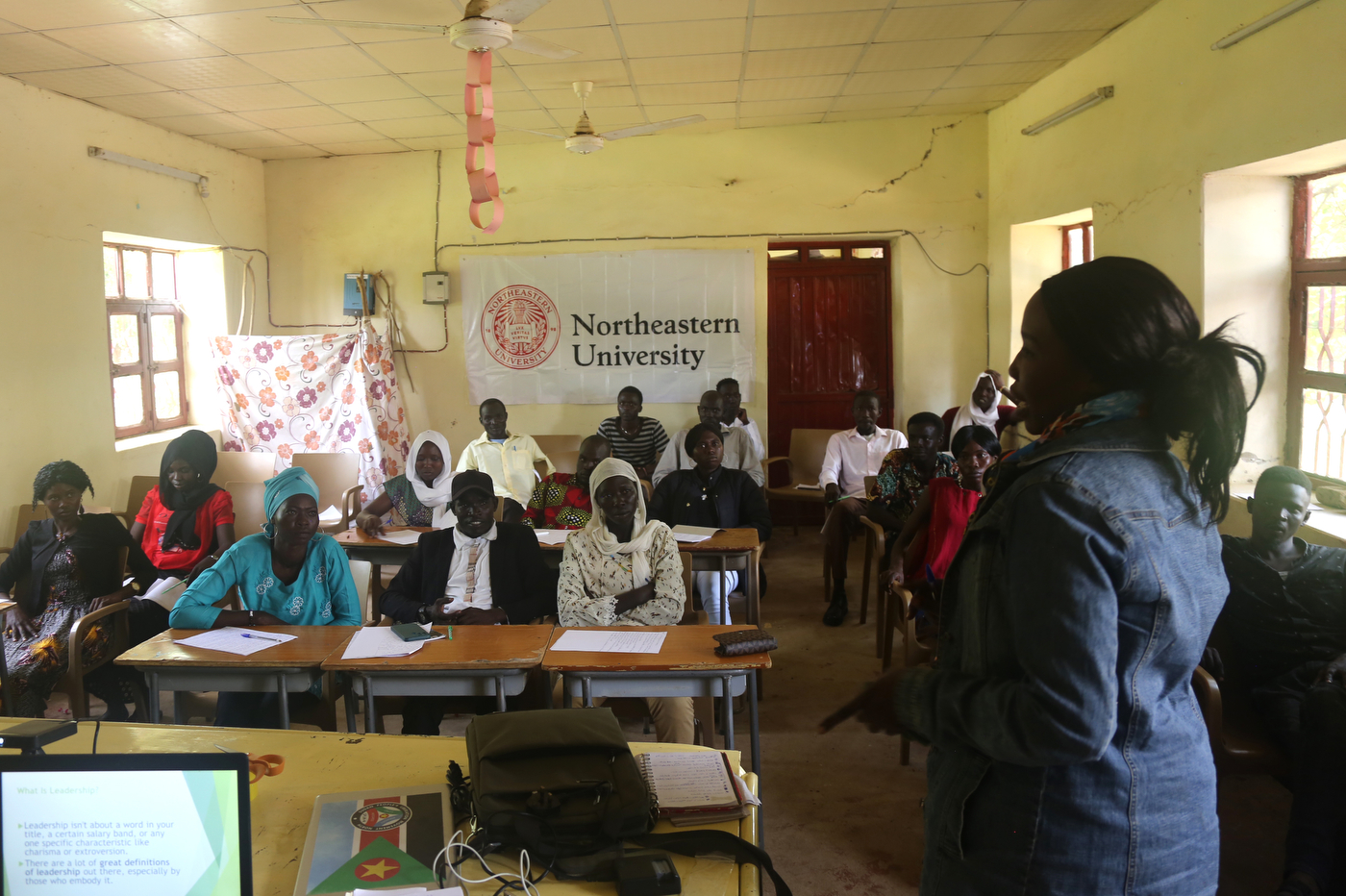Published on
The art of conflict resolution in Sudan
Khalid Kodi’s participatory art projects in his native Sudan and South Sudan aim to bring rival groups together, resolve conflicts and look to a better future. The Northeastern University professor is a mentor to many young Sudanese artists and activists.

Nine years ago, Khalid Kodi returned to his native Sudan to hold an art workshop in a war zone. Rebels in the Nuba Mountains, near Sudan’s southern border, were fighting for religious freedom and autonomy from Sudan’s central government, which responded by bombarding the region. But Kodi, now a Northeastern University art professor, thought the Nuba Mountains were the right place for his projects that invite people to create art.

Teaching in a war zone was “risky, but it’s life-changing and it’s rewarding,” recalls Kodi, who learned the locations of foxholes in case bombers flew over. “It’s [about] how people in this stressful condition can relate to visual creation, and what art can do for them in helping them to overcome the stress and trauma.”




Every summer since 2014, Kodi has traveled from Boston to Sudan to hold workshops for artists, as well as his Flags and Banners as Voices project, which encourages women and children, refugees and religious leaders to collaborate on artworks that express their opinions about their nation’s future.
This summer, Kodi will skip his usual trip to Khartoum, Sudan’s capital, if the fighting that erupted there in April is still raging. He’ll start in Juba, the capital of independent South Sudan, where he holds annual workshops with local artists. From there, he’ll travel north into the Nuba Mountains region—now autonomous—to hold his flags and banners project again. One of Kodi’s main goals is to get people from different ethnic groups or different religious groups to work together. Another is to teach conflict resolution and leadership skills.
In Kodi’s 2022 visit to the Nuba Mountains, funded in part by a summer development grant from Northeastern’s College of Arts, Media and Design, Kodi held his flag and banners workshop in the town of Kauda. A 2019 cease-fire between the rebels and Sudan’s then-new interim government had freed Kauda’s residents to think more about a better future.
The participants—mostly women, children, and disabled people from different religions and ethnicities—produced colorful banners, working with shiny cloth cut into shapes and sewn onto a fabric background. One bright yellow banner protested corruption in government and finance, showing a multi-colored train running up against obstructions on the tracks toward a blue sign labeled, “Prosperity Station.” Another banner, labeled “How to eradicate poverty in Africa,” included warm-colored cloth symbols of a tractor, a school and a factory. The participants presented their banners in a final show in the town square, which attracted 500 people.
During the academic year, Kodi teaches Observational Drawing and Color and Composition courses at Northeastern’s College of Arts, Media and Design, which he joined as a full-time professor of the practice in 2022, after teaching part-time in 2017 and 2021. He cuts a striking figure on Northeastern’s campus: He’s often dressed head-to-toe in black—black shirt and pants, a blank black baseball cap above black-framed glasses.
As an artist, Kodi’s past works have been influenced by Western, African and Islamic art. Two of his pieces hang in his office in Holmes Hall. In one, done in ink and liquid acrylic paint, a female figure contemplates another behind an ornate pattern of blue flowers and stems. It shows the influence of Islamic art patterns, African figure representations, and Western organization of space.
The other depicts a woman standing in an archway, with African decorations and patterns around her. She’s decorated by tribal marks. She holds an ax for self-protection. “I have a lot of interest in African women’s culture and the culture of the marginalized in Africa,” Kodi says. “When there’s war, usually women are victimized the most.”
Kodi has exhibited at Skoto Gallery in New York City and has work in the permanent collection of the Museum of the National Center of Afro-American Artists in Boston’s Roxbury neighborhood. But he’s spending less time on his solo work now. “All of that does not excite me anymore,” Kodi says. He’s shifted his focus to participatory art: “creating art with people who do not have the privilege of looking at art at the Museum of Fine Arts and fancy galleries.”
Inspiration for the Flags and Banners as Voices project came from African-American quilting—which, Kodi says, “addresses issues of memory and longing and relationship with time.” He’s found that creating flags and banners can be a balm for people divided by the region’s many conflicts. “There is a twist in all of my projects,” Kodi says. “I squeeze in the idea of how you can negotiate through the process of creating to solve problems—not to just run to a Kalashnikov [rifle] to resolve that problem.”
In 2016, at a refugee camp in Uganda, Kodi held a Flags and Banners as Voices session with South Sudanese women who’d fled a civil war. “Their husbands, their sons and brothers, they were fighting in South Sudan,” Kodi recalls. “When they came into the room, they didn’t want to talk to each other.” But soon, they began to agree on simple aesthetic elements of the project: some liked the color red, some the color blue. “It’s not threatening. It’s not serious, not direct. So that eased the conversation a little bit.”
Eventually, the women created banners that reflected their common hopes and concerns about South Sudan. “They created artwork about education, agriculture, music and culture,” Kodi says. “You find reasons to have them agree with each other without having very heavy discussions about complexity, politics and war. And at the end, the flags represent all of them and they all get to be at ease with each other.”
One reason Kodi takes his participatory art projects to the autonomous Nuba Mountains region is that he sympathizes with the rebels’ desire for religious freedom. Sharia law has long governed Sudan, but the Nuba Mountains’ residents include Black tribes with different religious beliefs, including Islam, Christianity and animism. Secularism is a key position of the rebel group, the Sudan People’s Liberation Movement-North.
“I do have relationships with the Indigenous groups,” says Kodi, “who I believe are on the right side, if we can say [that]—in war, I think there is no right or wrong side—but I think they are protesting atrocities against them.”
In 2020, a year after a cease-fire in the conflict, Kodi spoke at peace talks between the rebels and Sudan’s interim government. As an expert invited by the rebels, Kodi focused his presentation on ways that a secular state benefits art, science, human rights, and Indigenous rights.
During his summers, Kodi also helps the growing artistic community in South Sudan, which gained independence from Sudan in 2011—making it the world’s newest country. His workshops for young artists in Juba, the capital, include exposure to Impressionism, African American art and contemporary African art.
One goal of his mentorship is to give the young artists a more expansive knowledge of art than he received in Khartoum, where he got his bachelor’s degree in art in 1987. “The formal education [in Sudan] is very much European,” he says. “So there is no education about indigenous sculpture, indigenous African aesthetics, indigenous African art and artists. That’s something you have to do on your own.”
If he can’t visit Khartoum this year, Kodi will keep in touch from afar with the young activist-artists he knows there. In 2019, during a dramatic sit-in just before the collapse of former Sudanese leader Omar al-Bashir’s regime, many artists who Kodi knows painted the walls of buildings near the army headquarters.
“I still mentor artists there,” Kodi says. “And I still talk to them every day, even now, through Zoom.” Amid the fighting between Sudan’s two armies, activists and artists who Kodi knows are documenting atrocities and using spray paint as protest. “Young artists sneak into the different neighborhoods during the night, as the fighting’s going on,” he says, “and spray our slogan, ‘No War.’”
Erick Trickey is a Northeastern Global News Magazine senior writer. Email him at e.trickey@northeastern.edu. Follow him on Twitter @ErickTrickey.





